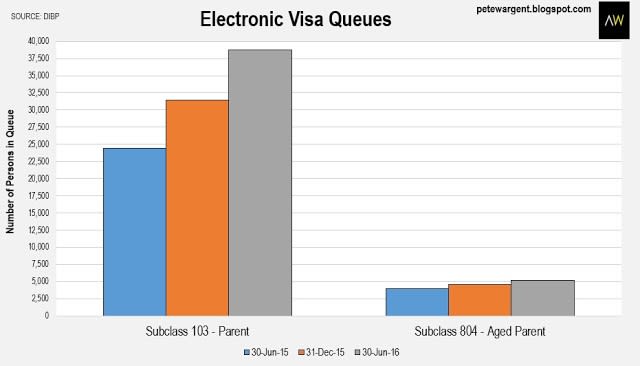Immigration levers and the apartment oversupply scenario: Pete Wargent
In Britain the topical political and media talk is of whether an "Australian-style" points based immigration system should be introduced, without any real clarity about what that would mean in practice.
Back Down Under it's often said that Australia's population growth must slow if the economy isn't creating enough jobs. This is essentially true for 457 visas, but does overlook the potential underlying demand for other visa classes.
I previously looked at the newly relaxed international student visa rules which were made effective from 1 July, easing the rules for parents and guardians of primary school age students in Australia.
The recent election campaign also led to some potentially interesting shifts via proposed policies for...
The recent election campaign also led to some potentially interesting shifts via proposed policies for...
Parent visa rules
In 2016, the percentage of Australians born overseas hit its highest level in 120 years at a massive 28 per cent.
Immigration policies understandably prefer immigrants to be of the young, working (or creating jobs through business), and tax-paying demographic.
Thus over the 2015/16 Migration Programme year, parent visa places were capped as follows:
Thus over the 2015/16 Migration Programme year, parent visa places were capped as follows:
- 1,500 places allocated to Parent (non-contributory) visas
- 7,175 places allocated to Contributory Parent visas
This means that your best chance of getting a parent visa in the last financial year was likely to pay the prohibitive A$47,000 for a contributory visa - about A$100,000 for a couple! - while successful sponsorship for standard parent visas was extremely hard to come by.
The unattractive alternative for parents wanting to join their families in Australia was to come in on a one year visitor visa, then leave the country for six months on each occasion. It would be a sore test of anyone's resolve to repeat this process over any meaningful period of time!
With some 6.8 million Australians having been born overseas the potential demand for parent visas is massive and growing, particularly from China and India.
I wouldn't believe anything a politician told me these days, but Google trends activity shows that there has been an explosion of interest in parent visas since the last full Census in 2011.
I wouldn't believe anything a politician told me these days, but Google trends activity shows that there has been an explosion of interest in parent visas since the last full Census in 2011.
It's worth noting that previous rules weren't favourable to Chinese families, due to China's one child policy meaning that most parents naturally had only one child in Australia, which was an obvious mathematical hindrance in proving that the balance of your family lived here.
As at 30 June 2016 due to the caps there were 38,770 persons in the queue for standard parent visas (up 59 percent from last year), and another 5,160 persons for aged parent visas (up 28 percent).
As at 30 June 2016 due to the caps there were 38,770 persons in the queue for standard parent visas (up 59 percent from last year), and another 5,160 persons for aged parent visas (up 28 percent).

With standard parent visas presently capped at 1,500 per year, a queue of this size at 30 June equated to a ridiculous 25.8 year average wait time for an application to be processed.
Election pledges
During a keenly contested election campaign the Australian Labor Party (ALP) announced plans to extend visitor visas to parents out to a far more palatable three years - with parents only being required to leave the country for four weeks at the end of each visa term and paying a $5,000 bond to ensure cover for medical and social services.
Surely a potential vote-winner for the ALP in the rapidly growing migrant communities, particularly in an era where so many young families also strive to be dual-income households.
Surely a potential vote-winner for the ALP in the rapidly growing migrant communities, particularly in an era where so many young families also strive to be dual-income households.
As tends to be the way of these things, the Coalition's knee-jerk response was to announce a new parent visa plan itself, especially aimed at Chinese and Indian visitors (provided that new arrivals pay for health insurance and don't rely on the welfare state for health care, shamelessly piggybacking from the ALP proposals!) and allowing for continuous five year visitor visas.
Given that the number of overseas born Aussies is soon to pass 7 million, such a policy could potentially lead to hundreds of thousands of applicants for visitor visas from parents sponsored by Australian citizens, largely from ageing, non-English speakers hailing from Asia (which is not really the ideal target demographic for policy makers).
For this reason the Coalition's proposed policy denotes that parents of Australian citizens and permanent residents who have lodged a permanent parental visa application "may" be issued a five year visa "on a case-by-case basis".
For this reason the Coalition's proposed policy denotes that parents of Australian citizens and permanent residents who have lodged a permanent parental visa application "may" be issued a five year visa "on a case-by-case basis".
In other words, this is an 'out'. Minister Dutton has the discretion to limit the number of visas issued and retains the right for policy to change course henceforth.
The wrap
At this juncture there appears to be very little clarity surrounding what will happen with respect to parent visas.
The Coalition probably doesn't know the answer itself, election pledges doubtless being dreamed up on the hoof in response to the ALP's evidently popular proposal.
A point here relevant to the property markets is that if Australia does end up with an oversupply of thousands of apartments as many have forecast, there are levers that can be pulled to loosen immigration policies.
After all, a sceptic would say that if there's a policy that's always guaranteed to garner support from governing parties of either persuasion, it's one aimed at propping up ailing capital city housing markets.
PETE WARGENT is the co-founder of AllenWargent property buyers (London, Sydney) and a best-selling author and blogger.
His latest book is Four Green Houses and a Red Hotel.
Pete Wargent
Pete Wargent is the co-founder of BuyersBuyers.com.au, offering affordable homebuying assistance to all Australians, and a best-selling author and blogger.

